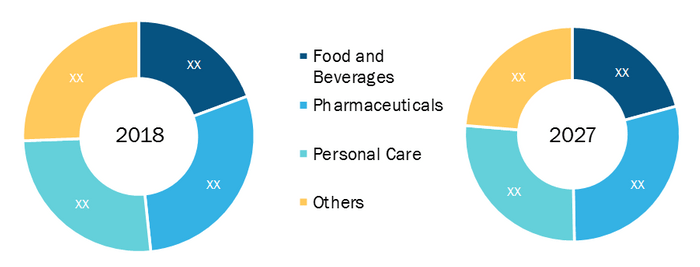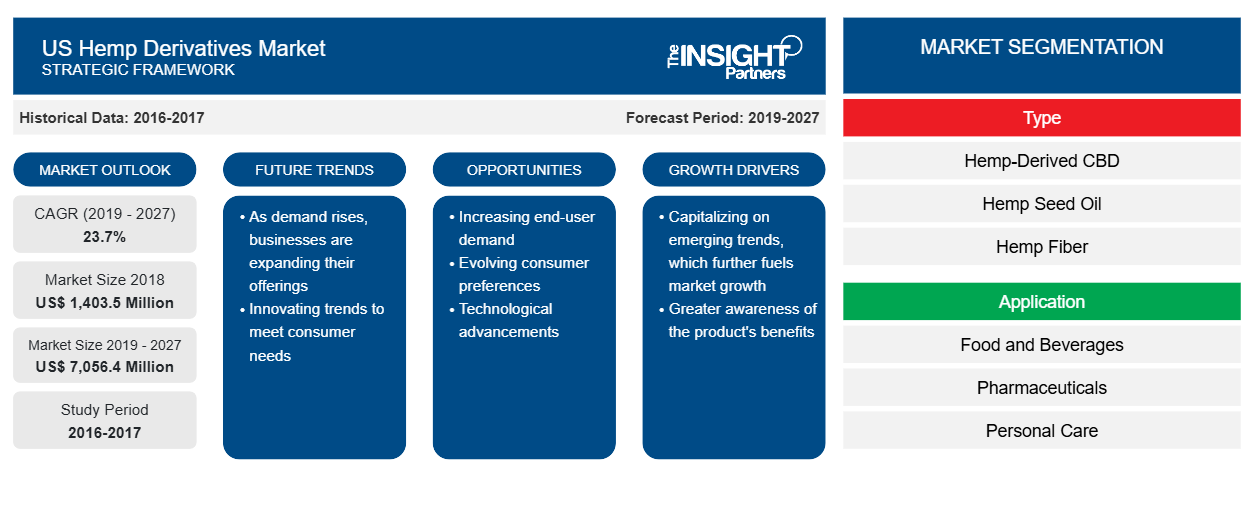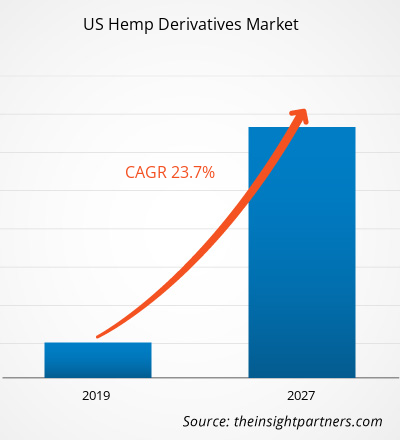The US hemp derivatives market was valued at US$ 1,403.5 Mn in 2018, and it is expected to grow at a CAGR of 23.7% during the forecast period 2019 – 2027 to reach US$ 7,056.4 Mn by 2027.
Hemp is regarded as a versatile plant that possesses various applications across numerous end-use industries. Hemp derivatives such as hemp-derived CBD, hemp fibers, hemp seed oil finds its application in food and beverage applications, textiles, nutritional supplements, fuels, plastic replacement, and others industrial bases. The demand for hemp has increased substantially among various sectors such as manufacturing, energy, pharmaceutical, medical, health care, and automotive industries.
Market Insights
Growing demand for hemp derivatives from several end use industries
Hemp is grown as a renewable form of raw materials that are used in the manufacture of several products. As the seeds and flowers of hemp plant are rich in nutrients, amino acids, and others, they are widely used in the manufacture of health promoting foods, body and skin care, products. Moreover, stalks and fibers of hemp are used in the production of clothes, paper, construction materials, plastic composites, and among others. The paper manufactured from hemp is considered superior to the tree-based paper as they offer longer life span and can be recycled several times. Apart from its use in production of paper, hemp is also used to manufacture fiberboard, which is quite stronger yet lighter in comparison to wood. Therefore, researchers are looking forward to substitute fiberboard made up of timber with the one from hemp, which would further promote sustainability. Hemp is also used in the production of durable, robust, and eco-friendly alternatives of plastic. Composites made from hemp are used to form petroleum-based plastics products. As the hemp seeds comprises a good amount of protein and nutrients, it acts as a substitute for soybean. Considering this fact, the hemp seed protein is used in the production of major products made from soybean, which includes tofu, butter, and cheese, burgers, ice cream, milk, and among others.
Application Insights
The US hemp derivatives market by application has been segmented into food & beverages, pharmaceuticals, personal care and others. In 2018, In 2018, the pharmaceuticals accounted for a larger share of the US hemp derivatives market. Hemp derivatives have long been valued across the world owing to its medicinal properties. It is a unique plant that is a rich source of omega 3, omega 6, and amino acids. It contains several vitamins such as A, B, B1, B2, B3, B6, C, E, and F along with minerals such as potassium, calcium, sulfur, magnesium, phosphorus, zinc, etc. Hemp comprises minimal THC, and large amounts of CBD, and primary restorative cannabinoid, which is extremely valuable as it offers various medical benefits. Hemp is promoted as a treatment for a range of conditions including epileptic seizures, post-traumatic stress disorder, anxiety and depression, diabetes prevention, alleviation of cancer symptoms, and inflammation. With such therapeutic and medicinal properties, hemp and its derivatives have gained significance and are being increasingly demanded across pharmaceutical applications and the production of nutritional supplements.
US Hemp Derivatives Market, by Application - 2018 & 2027

- This FREE sample will include data analysis, ranging from market trends to estimates and forecasts.
- This FREE sample will include data analysis, ranging from market trends to estimates and forecasts.
Type Insights
Based on the type, the US hemp derivatives market has been segmented into hemp-derived CBD, hemp fibers, hemp seed oil, and others. In 2018, others hemp derivatives segment which includes hemp flour and hempseed cake, cell fluid etc. is expected to grow at fastest growth rate during the forecast period.
The other hemp derivative includes hemp flour and hempseed cake, cell fluid, and extracts. Hemp flour is used in food & beverages industry. Hemp is a good source of fiber, vitamins, and minerals including magnesium, vitamin E, zinc, and iron. Hemp-based food products have gained immense popularity due to their easy digestibility on account of being free from gluten, allergens, genetically modified organisms (GMO), lactose, phytoestrogen, and pesticides. Consumption of hemp-based food products aids the maintenance of a healthy digestive system, which further drives the overall US hemp derivatives market. Hemp-based beverages are witnessing robust popularity due to their superior functional benefits, portion-controlled dosses, and easy availability. Thus, the growing demand for food and beverage items in the country is expected to boost the demand for hemp.
Hempseed cake is used in protein powder and animal feed; hemp extracts are used to produce oils, isolates, and distillates. Hemp cell fluid is used to produce number of chemicals that are processed further to produce chemical intermediates. Escalating demand for hemp derivatives from the above mentioned industries is driving the growth of the market for other hemp derivative in the US.
Customize This Report To Suit Your Requirement
You will get customization on any report - free of charge - including parts of this report, or country-level analysis, Excel Data pack, as well as avail great offers and discounts for start-ups & universities
US Hemp Derivatives Market: Strategic Insights

- Get Top Key Market Trends of this report.This FREE sample will include data analysis, ranging from market trends to estimates and forecasts.
You will get customization on any report - free of charge - including parts of this report, or country-level analysis, Excel Data pack, as well as avail great offers and discounts for start-ups & universities
US Hemp Derivatives Market: Strategic Insights

- Get Top Key Market Trends of this report.This FREE sample will include data analysis, ranging from market trends to estimates and forecasts.
Canada Hemp Foods Ltd, Colorado Hemp Works, LLC, Hempco Food and Fiber Inc., Z-Company BV, Bell Flavors & Fragrances Inc., Neptune Wellness Solutions, Inc., Radient Technologies, Aurora Cannabis Inc., Re Botanicals, Inc., Aphria Inc. are are amongst the key market players operating in the US hemp derivatives market. These companies are engaged in providing a comprehensive product portfolio of hemp derivatives. These market players are highly focused on providing high-quality hemp derivatives products which have high nutritional profile and strong application base in several application bases. The companies have realized the immense potential pertaining to hemp derivatives products and were highly involved in new development, merger and acquisition and among other strategies. For instance, in 2018, Bell Flavors & Fragrances EMEA introduced a line of botanical flavors and extracts sourced from hemp
US Hemp Derivatives Market - By Type
- Hemp-Derived CBD
- Hemp Seed Oil
- Hemp Fiber
- Others
US Hemp Derivatives Market - By Application
- Food and Beverages
- Pharmaceuticals
- Personal Care
- Others
Company Profiles
- Canada Hemp Foods Ltd
- Colorado Hemp Works, LLC
- Hempco Food and Fiber Inc.
- Z-Company BV
- Bell Flavors & Fragrances Inc.
- Neptune Wellness Solutions, Inc.
- Radient Technologies
- Aurora Cannabis Inc.
- Re Botanicals, Inc.
- Aphria Inc.
US Hemp Derivatives Market Report Scope
| Report Attribute | Details |
|---|---|
| Market size in 2018 | US$ 1,403.5 Million |
| Market Size by 2027 | US$ 7,056.4 Million |
| CAGR (2019 - 2027) | 23.7% |
| Historical Data | 2016-2017 |
| Forecast period | 2019-2027 |
| Segments Covered |
By Type
|
| Regions and Countries Covered | United State
|
| Market leaders and key company profiles |
|
US Hemp Derivatives Market Players Density: Understanding Its Impact on Business Dynamics
The US Hemp Derivatives Market is growing rapidly, driven by increasing end-user demand due to factors such as evolving consumer preferences, technological advancements, and greater awareness of the product's benefits. As demand rises, businesses are expanding their offerings, innovating to meet consumer needs, and capitalizing on emerging trends, which further fuels market growth.

- Get the US Hemp Derivatives Market top key players overview
Frequently Asked Questions
Which product type is leading the US hem derivatives market?
Cannabidiol (CBD) is a compound extracted from the leaves, stalks, and flowers of the hemp plant. Hemp-derived CBD provides broad-spectrum nutrition, offering a complex biochemical matrix of many constituents working synergistically. These compounds include phytocannabinoids, essential fatty acids, terpenes, plant sterols, chlorophyll, and vitamin E. CBD is a popular natural remedy used for many common diseases due to the absence of psychoactive effects. It is promoted as a treatment for a range of conditions, including epileptic seizures, post-traumatic stress disorder, anxiety and depression, diabetes prevention, alleviation of cancer symptoms, and inflammation
Which application is leading the US hem derivatives market?
Hemp has got a strong history regarding its medicinal values= Hemp derivatives are also known to possess several medicinal and therapeutic benefits. Hemp is a rich source of omega 3 and omega 6 fatty acids; amino acids; vitamin A, B, B1, B2, B3, B6, PP, C, E, and F; and minerals, such as potassium, calcium, sulfur, magnesium, phosphorus, and zinc. The presence of such compounds and nutrients helps reduce cholesterol levels in blood. Further, the vitamins present in hempseeds helps correct the functioning of nervous system, enhance abilities to restrain fatigue, along with improving the overall state of all tissues in skin and hair. Also, hempseed oil is used as an ideal supplement in the curing process of atopic eczema, and it is also suitable for all skin types.
What are the major driving factors to favor the US hemp derivatives market?
- Historical Analysis (2 Years), Base Year, Forecast (7 Years) with CAGR
- PEST and SWOT Analysis
- Market Size Value / Volume - Regional, Country
- Industry and Competitive Landscape
- Excel Dataset
Recent Reports
Testimonials
Reason to Buy
- Informed Decision-Making
- Understanding Market Dynamics
- Competitive Analysis
- Identifying Emerging Markets
- Customer Insights
- Market Forecasts
- Risk Mitigation
- Boosting Operational Efficiency
- Strategic Planning
- Investment Justification
- Tracking Industry Innovations
- Aligning with Regulatory Trends





















 Get Free Sample For
Get Free Sample For